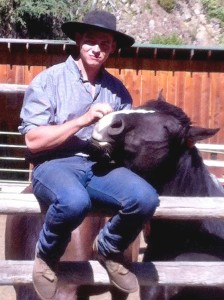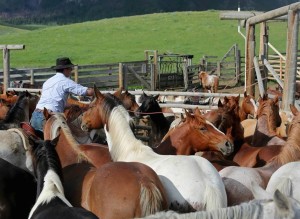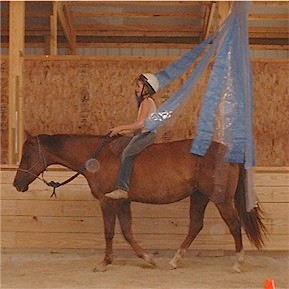In this second installment of Follow Fred, we learn how even a simple experiment can fill quickly with details and complexities. Here, we describe how Holcomb will test whether horses learn best with or without “dwell time.”
Read more of Follow Fred.
Studies show that animals, humans included, benefit from dwell time. That recess could be a five-minute break during a training session or a week-long break between training periods. Dwell time, says Martin Black and Dr. Steve Peters in Evidence-Based Horsemanship, allows horses to better absorb what they’ve learned, especially if left on a positive note.
Here is an outline of Holcomb’s summer research project:
The horses’ ability to navigate a naturally fear-inducing object (tarp) and respond to the experimenter’s cues will be behaviorally evaluated at the time of training and through video recordings.
Behavioral evaluation will include:
- Amount of time for initial crossing
- Number of refusals and/or flight from testing area
- Number of training sessions to hit criterion
- Number of horses meeting criterion
- Proportion of anxious crossings
- Instances of anxiety.
 Horses will be divided into two training groups.
Horses will be divided into two training groups.
One group will have the training sessions divided into one work period and one rest period (lengths of which will be determined after some pilot testing).
The other group will have training sessions divided into two work and two rest periods. This pattern of a work period followed by a rest period will be repeated so that the full session is composed of two work periods and two rest periods (work, rest, work, rest).
During the work period, the experimenter will ride the horse from a starting point in an arena towards a suspended tarp above a tarp-covered log. The experimenter/rider will use typical negative reinforcement strategies (applying leg and rein pressure to direct the horse toward the tarp and releasing all cueing pressure when the horse is moving forward through the tarp) to direct the horse through the hanging tarp and over the log.
During the rest period the experimenter/rider will allow the horse to stand quietly and will not cue the horse.
Adds Holcomb:
Moving through a hanging tarp is a naturally fear-inducing task meant to appropriately challenge the horses. The goal
is to see if one of the training conditions allows the horses to more quickly overcome that challenge and reach a certain crossing proficiency.
How the ranch horses responded to the tarp was something I could not accurately predict while at school in North Carolina. I knew that adjusting the task of negotiating the obstacle might be necessary. In other words, if they didn’t care at all, I’d have to make the task more difficult. If they wouldn’t get near it, I’d have to make it easier. It needed to be hard enough so that they have to work at it, but not so hard that it’d takes all summer to train a horse to complete whatever the obstacle is.


